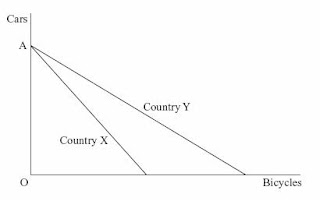0
Structured Question on Population
Posted by Economics Corner
on
5:42 AM
(a) Explain the term dependency ratio. [3]
(b) What would cause an increase in the dependency ratio? [4]
(c) How would the increase in the dependency ratio affect the followings?
(i) a government,
(ii) firms, and
(iii) the growth of the economy. [5, 5, 3]
Answers:
(a) Dependency ratio: formula = 2 marks: number of dependants (1 mark)
to the working population (1 mark) “ratio of dependants to working population” = 2 marks. 3m
(b) High birth rate 1 mark explanation/reason 1 mark,
low death rate 1 mark explanation/reason 1 mark.
Also accept change in school leaving age and change in retirement age.
2 x 2 marks 4m
(c)
(i) a government: Each problem identified 1 mark, development up
to 2 marks e.g. increase in government expenditure (1 mark) on
schools (high birth rate) (1 mark), health care (low death rate) (1
mark). Other problems include decrease in revenue from income
tax (1 mark), balance of payments problems (1mark) due to
decrease home production (1 mark) and increased imports (1
mark). 5m
(ii) firms: Each problem identified 1 mark, development up to 2
marks e.g. fewer workers (1 mark), increase in wages (1 mark),
decrease in profits. Other problems include change in demand for
goods and services (1mark), problems of ageing population being
reluctant to adopt to new ideas (1 mark). 5m
(iii) the growth of the economy: Each problem identified 1 mark,
development up to 2 marks. e.g. fewer workers (1 mark), less
production (1 mark), lower GDP (1 mark). Other problems include
less innovation (ageing population). 3m
(b) What would cause an increase in the dependency ratio? [4]
(c) How would the increase in the dependency ratio affect the followings?
(i) a government,
(ii) firms, and
(iii) the growth of the economy. [5, 5, 3]
Answers:
(a) Dependency ratio: formula = 2 marks: number of dependants (1 mark)
to the working population (1 mark) “ratio of dependants to working population” = 2 marks. 3m
(b) High birth rate 1 mark explanation/reason 1 mark,
low death rate 1 mark explanation/reason 1 mark.
Also accept change in school leaving age and change in retirement age.
2 x 2 marks 4m
(c)
(i) a government: Each problem identified 1 mark, development up
to 2 marks e.g. increase in government expenditure (1 mark) on
schools (high birth rate) (1 mark), health care (low death rate) (1
mark). Other problems include decrease in revenue from income
tax (1 mark), balance of payments problems (1mark) due to
decrease home production (1 mark) and increased imports (1
mark). 5m
(ii) firms: Each problem identified 1 mark, development up to 2
marks e.g. fewer workers (1 mark), increase in wages (1 mark),
decrease in profits. Other problems include change in demand for
goods and services (1mark), problems of ageing population being
reluctant to adopt to new ideas (1 mark). 5m
(iii) the growth of the economy: Each problem identified 1 mark,
development up to 2 marks. e.g. fewer workers (1 mark), less
production (1 mark), lower GDP (1 mark). Other problems include
less innovation (ageing population). 3m



